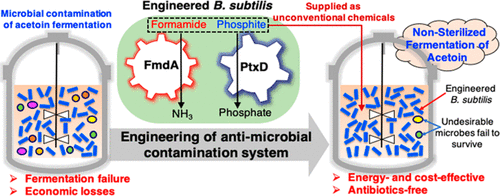当前位置:
X-MOL 学术
›
ACS Synth. Biol.
›
论文详情
Our official English website, www.x-mol.net, welcomes your
feedback! (Note: you will need to create a separate account there.)
Recruiting a Phosphite Dehydrogenase/Formamidase-Driven Antimicrobial Contamination System in Bacillus subtilis for Nonsterilized Fermentation of Acetoin.
ACS Synthetic Biology ( IF 3.7 ) Pub Date : 2020-07-29 , DOI: 10.1021/acssynbio.0c00312 Ze-Wang Guo 1 , Xiao-Yang Ou 1 , Shan Liang 1 , Hui-Fang Gao 2 , Liao-Yuan Zhang 2 , Min-Hua Zong 1 , Wen-Yong Lou 1
ACS Synthetic Biology ( IF 3.7 ) Pub Date : 2020-07-29 , DOI: 10.1021/acssynbio.0c00312 Ze-Wang Guo 1 , Xiao-Yang Ou 1 , Shan Liang 1 , Hui-Fang Gao 2 , Liao-Yuan Zhang 2 , Min-Hua Zong 1 , Wen-Yong Lou 1
Affiliation

|
Microbial contamination, especially in large-scale processes, is partly a life-or-death issue for industrial fermentation. Therefore, the aim of this research was to create an antimicrobial contamination system in Bacillus subtilis 168 (an ideal acetoin producer for its safety and acetoin synthesis potential). First, introduction of the formamidase (FmdA) from Helicobacter pylori and the phosphite dehydrogenase (PtxD) from Pseudomonas stutzeri enabled the engineered Bacillus subtilis to simultaneously assimilate formamide and phosphite as nitrogen (N) and phosphorus (P) sources. Thus, the engineered B. subtilis became the dominant population in a potentially contaminated system, while contaminated microbes were starved of key nutrients. Second, stepwise metabolic engineering via chromosome-based overexpression of the relevant glycolysis and acetoin biosynthesis genes led to a 1.12-fold increment in acetoin titer compared with the starting host. Finally, with our best acetoin producer, 25.56 g/L acetoin was synthesized in the fed-batch fermentation, with a productivity of 0.33 g/L/h and a yield of 0.37 g/g under a nonsterilized and antibiotic-free system. More importantly, our work fulfills many key criteria of sustainable chemistry since sterilization is abolished, contributing to the simplified fermentation operation with lower energy consumption and cost.
中文翻译:

在枯草芽孢杆菌中招募亚磷酸脱氢酶/甲酰胺酶驱动的抗菌污染系统,用于乙偶姻的非灭菌发酵。
微生物污染,尤其是在大规模过程中,在一定程度上是工业发酵的生死攸关的问题。因此,本研究的目的是在枯草芽孢杆菌168(因其安全性和乙偶姻合成潜力而成为理想的乙偶姻生产者)中创建抗菌污染系统。首先,来自幽门螺杆菌的甲酰胺酶 (FmdA) 和来自施氏假单胞菌的亚磷酸脱氢酶 (PtxD) 的引入使工程枯草芽孢杆菌能够同时同化甲酰胺和亚磷酸盐作为氮 (N) 和磷 (P) 源。因此,工程化的枯草芽孢杆菌成为潜在污染系统中的主要种群,而受污染的微生物缺乏关键营养素。其次,与起始宿主相比,通过相关糖酵解和乙偶姻生物合成基因的基于染色体过表达的逐步代谢工程导致乙偶姻滴度增加了 1.12 倍。最后,使用我们最好的乙偶姻生产商,在补料分批发酵中合成了 25.56 g/L 乙偶姻,在未灭菌和不含抗生素的系统下,生产率为 0.33 g/L/h,产量为 0.37 g/g。更重要的是,由于取消了灭菌,我们的工作满足了可持续化学的许多关键标准,有助于以更低的能耗和成本简化发酵操作。
更新日期:2020-09-20
中文翻译:

在枯草芽孢杆菌中招募亚磷酸脱氢酶/甲酰胺酶驱动的抗菌污染系统,用于乙偶姻的非灭菌发酵。
微生物污染,尤其是在大规模过程中,在一定程度上是工业发酵的生死攸关的问题。因此,本研究的目的是在枯草芽孢杆菌168(因其安全性和乙偶姻合成潜力而成为理想的乙偶姻生产者)中创建抗菌污染系统。首先,来自幽门螺杆菌的甲酰胺酶 (FmdA) 和来自施氏假单胞菌的亚磷酸脱氢酶 (PtxD) 的引入使工程枯草芽孢杆菌能够同时同化甲酰胺和亚磷酸盐作为氮 (N) 和磷 (P) 源。因此,工程化的枯草芽孢杆菌成为潜在污染系统中的主要种群,而受污染的微生物缺乏关键营养素。其次,与起始宿主相比,通过相关糖酵解和乙偶姻生物合成基因的基于染色体过表达的逐步代谢工程导致乙偶姻滴度增加了 1.12 倍。最后,使用我们最好的乙偶姻生产商,在补料分批发酵中合成了 25.56 g/L 乙偶姻,在未灭菌和不含抗生素的系统下,生产率为 0.33 g/L/h,产量为 0.37 g/g。更重要的是,由于取消了灭菌,我们的工作满足了可持续化学的许多关键标准,有助于以更低的能耗和成本简化发酵操作。











































 京公网安备 11010802027423号
京公网安备 11010802027423号